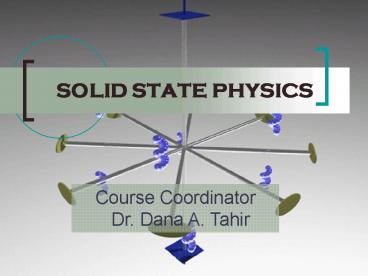SOLID STATE PHYSICS PowerPoint PPT Presentation
1 / 11
Title: SOLID STATE PHYSICS
1
SOLID STATE PHYSICS
Course Coordinator Dr. Dana A. Tahir
2
CHAPTER 1 CRYSTAL STRUCTURE
- Elementary Crystallography
- Typical Crystal Structures
- Elements Of Symmetry
3
Objectives
- By the end of this section you should
- be able to identify a unit cell in a symmetrical
pattern - know that there are 7 possible unit cell shapes
- be able to define cubic, tetragonal, orthorhombic
and hexagonal unit cell shapes
4
matter
5
Gases
- Gases have atoms or molecules that do not bond to
one another in a range of pressure, temperature
and volume. - These molecules havent any particular order and
move freely within a container.
6
Liquids and Liquid Crystals
- Similar to gases, liquids havent any
atomic/molecular order and they assume the shape
of the containers. - Applying low levels of thermal energy can easily
break the existing weak bonds.
Liquid crystals have mobile
molecules, but a type of long range order can
exist the molecules have a permanent dipole.
Applying an electric field rotates the dipole and
establishes order within the collection of
molecules.
7
Crytals
- Solids consist of atoms or molecules executing
thermal motion about an equilibrium position
fixed at a point in space. - Solids can take the form of crystalline,
polycrstalline, or amorphous materials. - Solids (at a given temperature, pressure, and
volume) have stronger bonds between molecules and
atoms than liquids. - Solids require more energy to break the bonds.
8
ELEMENTARY CRYSTALLOGRAPHY
9
Types of Solids
- Single crsytal, polycrystalline, and amorphous,
are the three general types of solids. - Each type is characterized by the size of ordered
region within the material. - An ordered region is a spatial volume in which
atoms or molecules have a regular geometric
arrangement or periodicity.
10
Crystalline Solid
- Crystalline Solid is the solid form of a
substance in which the atoms or
molecules are arranged in a definite,
repeating pattern in three dimension. - Single crystals, ideally have a high degree of
order, or regular geometric periodicity,
throughout the entire volume of the material.
11
Crystalline Solid
- Single crystal has an atomic structure that
repeats periodically across its whole volume.
Even at infinite length scales, each atom is
related to every other equivalent atom in the
structure by translational symmetry
Single Pyrite Crystal
Amorphous Solid
Single Crystal

